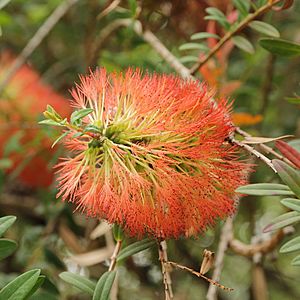Hillock bush facts for kids
Quick facts for kids Hillock bush |
|
|---|---|
 |
|
| Cultivated specimen, Quito, Ecuador. | |
| Scientific classification | |
| Genus: |
Melaleuca
|
| Species: |
hypericifolia
|
The hillock bush, also known as Melaleuca hypericifolia, is a beautiful plant from the myrtle family. It grows naturally in New South Wales, Australia. This plant is famous for its bright orange to red flowers, which grow in spikes. Because of its pretty flowers, many people like to grow it in their gardens.
In 1797, a scientist named James Edward Smith described it as "The most beautiful of the genus." He noted that it grew in wet, swampy areas. People in England often thought it was a different plant called Hypericum until its lovely flowers appeared.
Contents
What Does the Hillock Bush Look Like?
The hillock bush is a large, woody shrub or a small tree. It can grow up to about 6 meters (20 feet) tall. It has bark that looks grey and feels like paper.
Its leaves are special because they grow in opposite pairs, one after the other. They are usually 10 to 40 millimeters (0.4 to 1.6 inches) long and 4 to 10 millimeters (0.16 to 0.4 inches) wide. They are narrow and oval-shaped, with a small groove on the top.
Flowers and Fruit
The flowers of the hillock bush are red to orange. They grow in a spike, usually on the older branches of the plant. Each flower spike can be up to 60 millimeters (2.4 inches) wide and long. A single spike can have as many as 40 individual flowers! The petals are about 4.5 to 7 millimeters (0.18 to 0.28 inches) long and fall off as the flower gets older.
Inside each flower, there are five groups of stamens (the parts that make pollen). Each group has 16 to 25 stamens. The flower spikes usually appear in spring and summer.
After the flowers, the plant grows woody, oval-shaped fruits called capsules. These capsules are about 5 to 6.5 millimeters (0.2 to 0.26 inches) long. As the plant gets older, these capsules often grow very close together.
How the Hillock Bush Got Its Name
The hillock bush was first officially described by an English botanist named James Edward Smith in 1797. He wrote about it in a scientific paper called Transactions of the Linnean Society of London. He studied plants that were found in "swampy ground" in New South Wales.
The plant's scientific name, hypericifolia, comes from the fact that its leaves look similar to those of another plant genus called Hypericum.
Where Does the Hillock Bush Grow?
The hillock bush naturally grows in wet areas like sandy heathlands and woodlands. You can find it mostly along the coast of New South Wales, from Bermagui up to Sydney. It also grows a bit further inland, reaching the Blue Mountains.
This plant has also started to grow in the wild in South Australia and Victoria, even though it's not native to those areas.
Growing Hillock Bush in Gardens
The hillock bush is a strong, adaptable, and attractive shrub. It has been a popular garden plant for many years. It can handle a bit of frost, but sometimes its beautiful flowers might be hidden inside the plant's dense leaves.
It makes a great plant for creating a thick screen or hedge in a garden. However, if you want to show off its flowers, you might need to prune it.
It's important to know that in some areas, especially in southern Victoria, the hillock bush has spread from gardens into the natural bushland. This can sometimes cause problems for native plants. So, if you're thinking of planting it, it's good to be aware of how it might spread in your area.
Two special types of hillock bush have been created for gardens:
- M. hypericifolia 'Snapper Point'
- M. hypericifolia 'Ulladulla Beacon'


